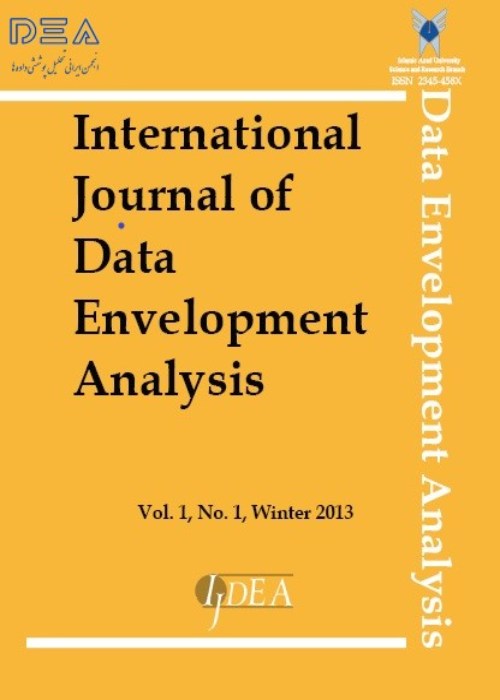فهرست مطالب
International Journal of Data Envelopment Analysis
Volume:9 Issue: 2, Apr 2021
- تاریخ انتشار: 1400/01/12
- تعداد عناوین: 6
-
Pages 1-8The Malmquist Index is the prominent Index for measuring the productivity change of Decision Making Units (DMUs) in multiple time periods that use Data Envelopment Analysis (DEA) models with Variable Return to Scale (VRS) and Constant Return to Scale (CRS) technology. One of the drawbacks of DEA is the problem of lack of discrimination among efficient DMUs and hence yielding many numbers of DMUs as efficient. The main purpose of this paper is to overcome this inability. In this paper, we compute the Malmquist Index based on means of weights evaluation, and by using this method we can rank DMUs by logical criteria. For illustration numerical example is given.Keywords: Data envelopment analysis (DEA), Decision Making Units (DMUs), Means of Weights, Malmquist index
-
Pages 9-22The concept of efficiency in economic literature is the highest output with a certain amount of input and vice versa. Today, in order to measure the degree of efficiency, two categories of methods are used, which are parametric methods and non-parametric methods. In this paper, considering the non-parametric methods which are based on mathematical planning methods, the efficiency of Iran's tourism industry is evaluated in comparison with other countries in the region. It is worth mentioning that the main advantage of data envelopment analysis method over other existing methods for measuring performance is that it can be used to evaluate the performance of units that have multiple inputs and non-convertible multiple outputs.In the present article, according to the inputs and outputs of the tourism industry in each of the countries in the region in 2018, their efficiency has been evaluated with the two assumptions of return to fixed scale and return to variable scale.Keywords: Data Envelopment Analysis, Efficiency, tourism industry
-
Pages 23-28All managers need to evaluate the units under their supervision. To evaluate the units, they must determine the evaluation indicators and then calculate the efficiency of each unit with the help of these indicators. In practice, many indicators may not be small, but have a qualitative value or their values are fuzzy in this article we want to calculate the units under evaluation that have the same inputs and outputs. To evaluate the performance of these units with fuzzy data, first for each unit, we calculate the nature of the output in such a way that according to the desired input, what can be the maximum value of the output because the number of outputs is more than one, so we have a multi-objective linear programming problem to be answered by solving the multi-objective linear programming problem We use flexible fuzzy. In the introduced model, we first change the fuzzy linear programming problem to a multi-objective linear programming problem with three objective functions using the alphabetical method arranged on triangular fuzzy numbers, so using this method is an optimal solution. Lexicography of the ML problem We find OP.Keywords: Data Envelopment Analysis, Efficiency, Multi-objective linear programming problem. Fuzzy multi-objective linear programming problem
-
Pages 29-44One of the components of large companies that, with the support of their competent and efficient managers, are analyzing the capital market, raw materials and products every day, is an accurate calculation tool to advance future goals.After the end of financial periods and through news and media, announcements of profit and loss, balance sheet and earnings per share and finally changes in stock prices of companies in the capital market are provided to us. Obviously, companies that have achieved better profitability rates and have increased the value of investor stocks have a better position in this market, and other companies have the ability to gain points that have led to positive changes in the market. They maintain their competition to achieve much higher.In this paper, the financial information of 10 petrochemical companies that are members of the stock exchange for 11 consecutive years is classified by performance appraisal techniques and finally, according to the market analysis and methods used, the results related to the returns of these companies are classified. Has been.Keywords: Return to Scale - Performance Evaluation of Financial Statements - Efficiency - Data Envelopment Analysis - Returns, Securities
-
Pages 45-54One of the important issues discussed in DEA literature is ranking efficient units. This paper presents a new method based on slack based measure SBM with free variables in sign for ranking efficient units. The new method also can rank the efficient units non-extreme. It also does not have the problem of instability and infeasibility. The proposed model specifies the largest MPSS and after that other unit’s portraits to this unit. Then, using examples will be compared with the approaches.Keywords: Data Envelopment Analysis, Ranking, Efficiency
-
Pages 55-64Data envelopment analysis is a non-parametric method based on mathematics, which is used to evaluate the performance of a set of homogeneous decision-making units in a production technology with multiple inputs and outputs. The idea of performance evaluation in two-stage systems is one of the topics. It is of interest in data coverage analysis. In two-stage systems, all or part of the outputs of the first stage is considered as the input of the tail stage. This input of the second stage can be considered favorable or unfavorable. Arithmetic or geometric models can be used to calculate the efficiency of the decision-making units. Therefore, in this article, the evaluation of efficiency in two-stage systems with undesirable outputs is discussed using the product method. According to the new model presented, the efficiency of 6 regions in China was measured. It should be noted that every region of China has provinces and cities that have the same geographical, natural, etc. conditions.Keywords: Data Envelopment Analysis, efficiency of two-stage systems, desirable output, Undesirable Output, product method


